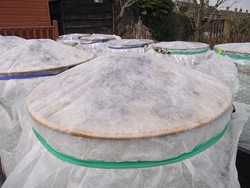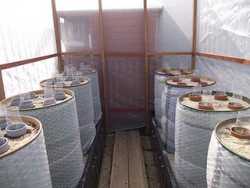
John Trim
Show grower John Trim has won the national championship with his carrots. In this article on growing long rooted carrots for show, he reveals the secrets of cultivating and staging long rooted carrots for exhibition to get you the winner’s red card at the show.
What Variety of Carrot to Grow for Show
There is only one variety of long carrot suitable for show and that is ‘New Red Intermediate’.
The one big problem with growing long roots is that you are never quite sure what is going on down below the surface of the growing medium. That’s probably why long carrots & parsnips can be real heartbreakers when it comes to pulling for show.
But never fear, by growing with the guidance of past champions you will be in with a good chance of success, as demonstrated by first time grower Darren Blick when he won the National Vegetable Society Southern Branch Championships in 2011. Mind you he was mentored by one of the best carrot growers in the country, former national champion Bob Brown from Broughton in Hampshire.
Preparing the growing medium for long carrots

Darren Blick from Salisbury with his prizewinning long carrots
I will start by describing the medium for long carrots, Most top growers will use barrels or some sort of container filled with sand. These are then stood on a raised bed of either breeze blocks or a scaffold board deep bed filled with sand.
The object is to be able to bore a hole in the sand to a depth of five feet (1.5 metres). Some like to bore the hole with a 6’ crowbar to the required depth, then rotating it until the diameter of the hole at surface level is approximately 4”/100mm wide. For ease of use this is method I usually employ.
In the last few years many successful carrot growers have been taking out a core of sand using a drainpipe with an internal diameter of 3”/75mm. The pipe is pushed down through the sand to the required depth, given a couple of twists and carefully withdrawn.
The sand must be damp or the core will fall out of the pipe and the hole may collapse. The advantage of this system is that at the end of the growing season when all the roots have been pulled you can reinsert the pipe and with draw the compost core, thereby keeping your sand clean.
Compost Mixes for Long Carrots

Carrot and parsnip barrels set up atop deep beds and all filled with sand. That’s me, John Trim, about 15 years ago
Every champion carrot grower has his own mix. This one was given to me by former national champion Gerald Treweek and enabled me to win the Southern branch NVS Championship some years ago.
- 40 litres of sphagnum moss peat
- 10 litres of silver sand
- 10 litres of sterilised Wessex loam
- Mix together and put through a fine sieve.
To the mix add the following fertilisers. 1oz Potash. 1oz Super Phosphate. 1oz Kieserite (magnesium sulphate). 2oz of ground limestone. 1oz Calcified Seaweed. Before adding to the compost break the fertiliser down by pushing through a flour sieve or blitz it up in a coffee grinder.
Bob Browns long carrot compost mix
- 3 gallons of sterilised top soil
- 3 gallons of multi purpose compost
- 3 gallons of silver sand
- 1 gallon of fine vermiculite
- 6ozs of base top dressing. (from Chempak or Vitax)
- 4ozs of calcified seaweed
- 4ozs of ground limestone
Mix all the component parts together very well. I put the lot through my garden shredder which also pulverises any lumps in the compost. Some growers buy an electric cement mixer to do the job. Fill the bore holes one month before seed sowing begins. Don’t forget to tamp the compost down as you fill each bore hole in turn to exclude any air pockets.
Sowing dates for long carrots.
If growing for an early end of July show then sow in the first week of March. For late August shows sow on 9th April and the late September shows 28th April.
Sowing long carrots

Carrots under Fleece
Photo courtesy Darren Blick
Make a depression with your finger and sow 3 to 4 seeds per borehole. Lightly cover with compost and moisten with warm water. Put down slug pellets then cover the barrels with a layer of fleece plus a layer of polythene. These are held in place with strong elastic.
Within 2 to 3 weeks the seed will germinate. When the young plants are about 3” tall thin them down to the strongest seedling. Remove the polythene but leave the fleece in place as protection against frost.
Cultivating Long Carrots
The drums are enclosed in an enviromesh cage to protect the carrots from Willow aphids and Carrot Root fly. At each borehole a section of 3” downpipe has been inserted over each carrot. This is topped up with compost to prevent greening of the shoulders of the carrot crown.

Insulated Carrot Barrels
Photo courtesy Darren Blick
Remove the fleece when the temperature climbs above 21c. Notice the bottomless plastic bottles giving the young seedlings their own micro climate whilst providing protection.
The drums are encased in bubble wrap and polythene to lift the sand temperature as the ideal growth range for carrots is between 16c / 21c, above or below that and it could compromise the root development.
For the first few weeks the carrots are watered overhead as and when they need it. Look for the compost drying at the surface level. Once the carrots are growing strongly water is also applied to the base of the drums. The thought behind this is that the root will detect the moisture and grow towards it and hopefully produce a longer carrot. From now on overhead watering is left to natural rainfall, unless we have a very dry growing season.
Lifting for show
Exhibiting Long Carrots
Once at the show the foliage must be trimmed back to 3”/75mm. Nip of all the fine hair roots you can see and arrange the carrots side by side on a strip of black material to show the exhibit off to best effect. Cover with a damp cloth and leave for the stewards to remove.
Don’t forget your exhibitors card and to write the variety on a cultivar card.
Growing Carrots for Show Articles by John Trim
- Growing Long Carrots for Show – Long Rooted Carrots
- Growing Stump Rooted Carrots for Show – Preparation
- Growing Stump Rooted Carrots for Show – Cultivation to Showing



